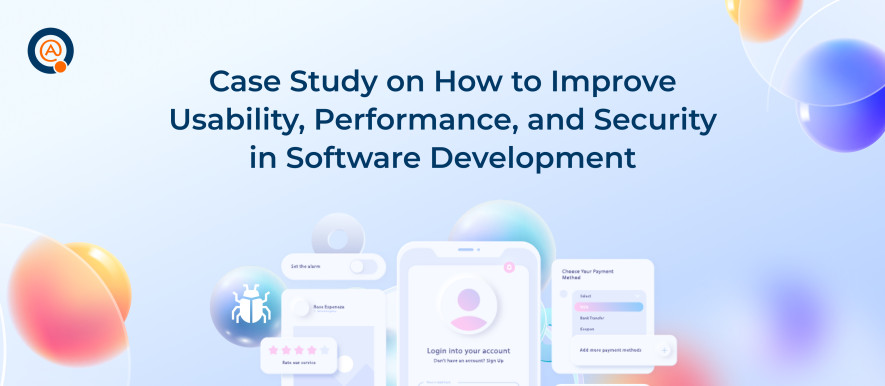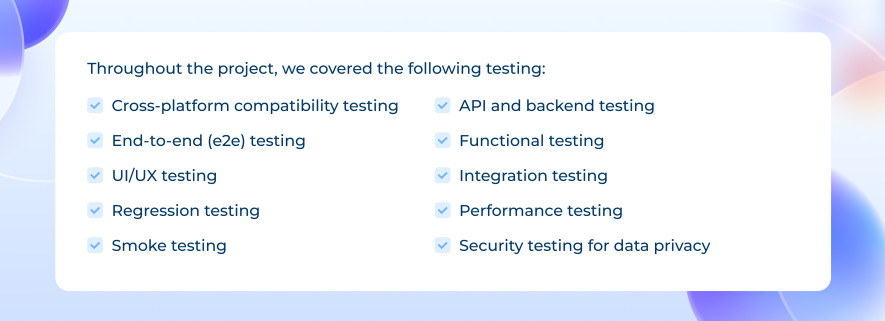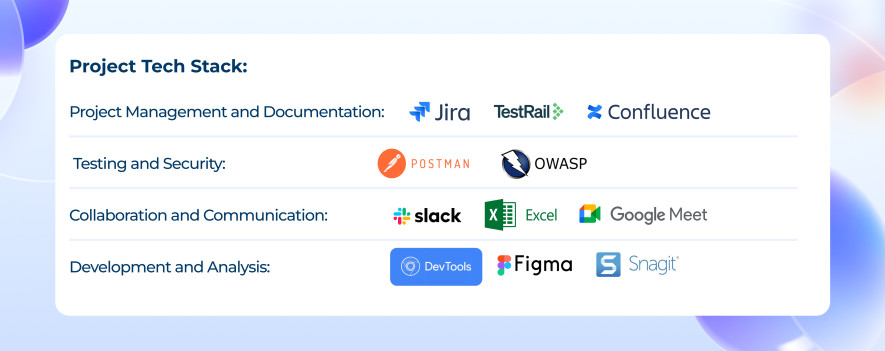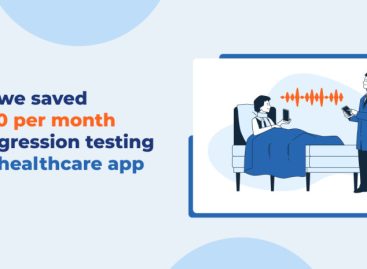- QATestLab Blog >
- Mobile Testing >
- Software Development (Doesn’t) Need Independent QA
Software Development (Doesn’t) Need Independent QA

In the fast-paced world of software development, a well-polished release gives higher ground over competition. The ocean is so red that everyone is forced to move fast, but if things are broken, the user won’t wait long to pick a competing app. Underdone documentation, the need for frequent updates, and the constant search for innovation make it hard to organize the process without dragging the quality down.
With so much on the plate, a holistic approach to quality assurance may seem impossible. However, that’s exactly the issue independent testing companies can help solve. A dedicated QA team brings expertise and structure to testing, giving space to streamline release cycles, enhance security, and improve team collaboration through documentation and communication support.
In this case study, we will dissect a recent project where QATestLab helped a software development company build a scalable, user-friendly, and stable fitness and health-tracking app.
Software Development Startup with Fitness App
A young, bootstrapped startup was building a fitness app for iOS and Android. Data precision was a top priority with features like real-time activity tracking and monitoring health metrics like heart rate, burned calories, and distance. The platform also had social features for sharing progress, workout challenges, and community engagement, which required the app to be secure and user-friendly. Other ambitious goals were integrating wearable devices and synchronising with Apple Health and Google Fit.
Stability, Compatibility and Other Needs
With a pretty ambitious objective to build a reliable, engaging, and secure app, the client faced the following challenges:
- Balancing between frequent updates and maintaining a stable app to stay competitive;
- Dealing with documentation gaps caused by rapid development to avoid consistency and troubleshooting challenges;
- Handling functional and regression testing to sustain platform stability after each release;
- Creating a user-friendly environment to drive long-term engagements through usability;
- Ensuring compatibility across different devices and operating systems to grant stable performance;
- Building a secure and scalable architecture to protect personal information;
- Establishing robust integrations to sync the app with wearables and health platforms efficiently;
Our job was to address these common software development challenges from the QA standpoint. This required efficient communication between the teams, a thorough approach to planning and execution, and extensive reporting to keep the client informed. To fulfill these needs, we assigned the managed testing setup, with the Project Manager coordinating the team of QA Engineers.
Delivering Seamless User Experience Through QA
The project started with thorough preparation. Our team analyzed the current client’s operations and drafted an action plan to optimize the quality assurance process. In software development, it’s critically important to create a strong foundation for each process to streamline the routine and ensure no resources go in vain.
Setting Direction with Test Plan
Our first step was developing a test plan that prioritized critical user journeys like activity tracking, health metrics, and social sharing. Dissecting the process and creating a step-by-step scheme of what should be done to reach the project goals is one of the fundamentals for successful execution. For reference, you can check out our sample test plan at the following link.
Defining Improvement Zones with Compatibility Matrix
As the app should work equally well both on Apple and Android devices, it was essential to identify the ones where it performs worse than expected. Our team compiled a compatibility matrix that included various smartphone models and popular wearables to address that. This allowed us to cover the necessary range for performance and integration tests.
Sharing Insights with Daily Syncs and DocumentationThe next step was to organize the knowledge transfer to keep the client’s development and product management teams abreast. This includes two aspects: regular communication and extensive documentation. On the latter, our team has created over 400 test cases to ensure each new feature was clearly documented before the release. You can find some sample test cases at this link. The communication was based on daily sync meetings, where we discussed any recent issues or plan changes.

Meeting Requirements with Functional Testing
All these actions allowed our team to transit to the testing process efficiently. We started with functional testing to validate the features the client was working on. While validating the functionality to meet the requirements, our team also simulated real-world scenarios to ensure comprehensive coverage. The testers set up real-user profiles and simulated workouts in production-like environments, increasing the number of bugs we caught.
Making It Look Smooth with UI/UX Testing
We strongly emphasised usability and UI testing to check whether the new and existing features add to the pleasant user experience. Our team reviewed the interface’s responsiveness, navigation ease, and visual consistency across devices, focusing on creating a seamless, intuitive user journey. Through continuous usability assessments, we helped refine elements essential for engagement and make the app accessible and enjoyable for a broad user base.
Streamlining Data with Integration and Security Testing
Considering integration with other devices and health apps was one of the platform’s key features, the team dedicated a lot of effort to ensuring synchronization. Another important aspect was testing the APIs to verify the robust performance of backend functionality. As the app processed and transferred sensitive data, our QA Engineers also took care of security testing to ensure it was properly protected and the software fully complied with the existing standards and regulations.
Investing in Growth with Performance Testing
One of the most common issues software development companies face is a lack of scalability. Early development is often based on simpler infrastructure, and further expansion with new features and modules can strain the architecture. A growing user base can also put pressure on the platform if it isn’t properly prepared, increasing the risk of downtime.
To tackle both potential issues, we also involved our QA Architect, who helped ensure product performance and scalability. His guidance was crucial for improving app capabilities to handle more integrations, new modules, and increased user load. Along with that, we took care of performance checks focusing on stress tests to prevent slowdowns during high activity and workouts. Test results were supplemented with infographics for easier perception; you can see a sample here.

Keeping Users Satisfied with Post-Release Support
The post-release phase is as important as the pre-release in quality assurance for software development. We established a structured release and hotfix management approach to ensure the app runs as intended, prioritizing performance and critical bug fixes. A scheduled update workflow was developed to minimize disruptions, ensuring rapid issue processing during testing and consistent improvement cycles.
Our team has also worked directly with end users, handling health metrics and data synchronization issues. This was important for user confidence in the app’s reliability. We maintained a product roadmap and documented release notes to keep all stakeholders aligned. In addition, we conducted ongoing market research on fitness trends, providing recommendations on relevant features to keep the application relevant and engaging for users.
Streamlined Software Development for Product Stability
Just like actively improving the app functionality and stability, the client sought improved operations to prevent disrupted processes and build reliable software. Our role was not only to test the platform but also to help fine-tune internal procedures and provide the foundation for further growth. One of the key achievements of the project was enhanced documentation and streamlined team communication, which helped to maintain the app’s high quality and efficient workflows.
A better process leads to a better product. Both sides’ collaborative efforts, 400+ test cases, and thorough approach to testing increased the reliability of core features like activity tracking, health data synchronization, and social sharing. Users also observed improved performance with faster load times, better memory management, and smoother responsiveness. A bit less noticeable (but not less important) aspect that was secured throughout the project was data protection, as now the app fully complies with security standards.
If your team finds it challenging to keep up with quality and innovation, partnering with a dedicated QA provider could make a big difference. An experienced testing team can bring structure to release cycles, help you improve user experience, and keep your application running smoothly.

Feel free to contact QATestLab to explore how a thoughtful approach to quality assurance can support your development goals and help build software that truly connects with your users. Together, we can make sure your app is reliable, user-friendly, and ready to succeed.
Learn more from QATestLab
Related Posts:
- Automation Testing for Mobile Apps: Why It’s Essential and Our Key Services
- How One Bug Can Wreck Your Reputation — And How QA Prevents It
- QA Tech Lead: Test Digital Health Software Better
About Article Author
view more articles






